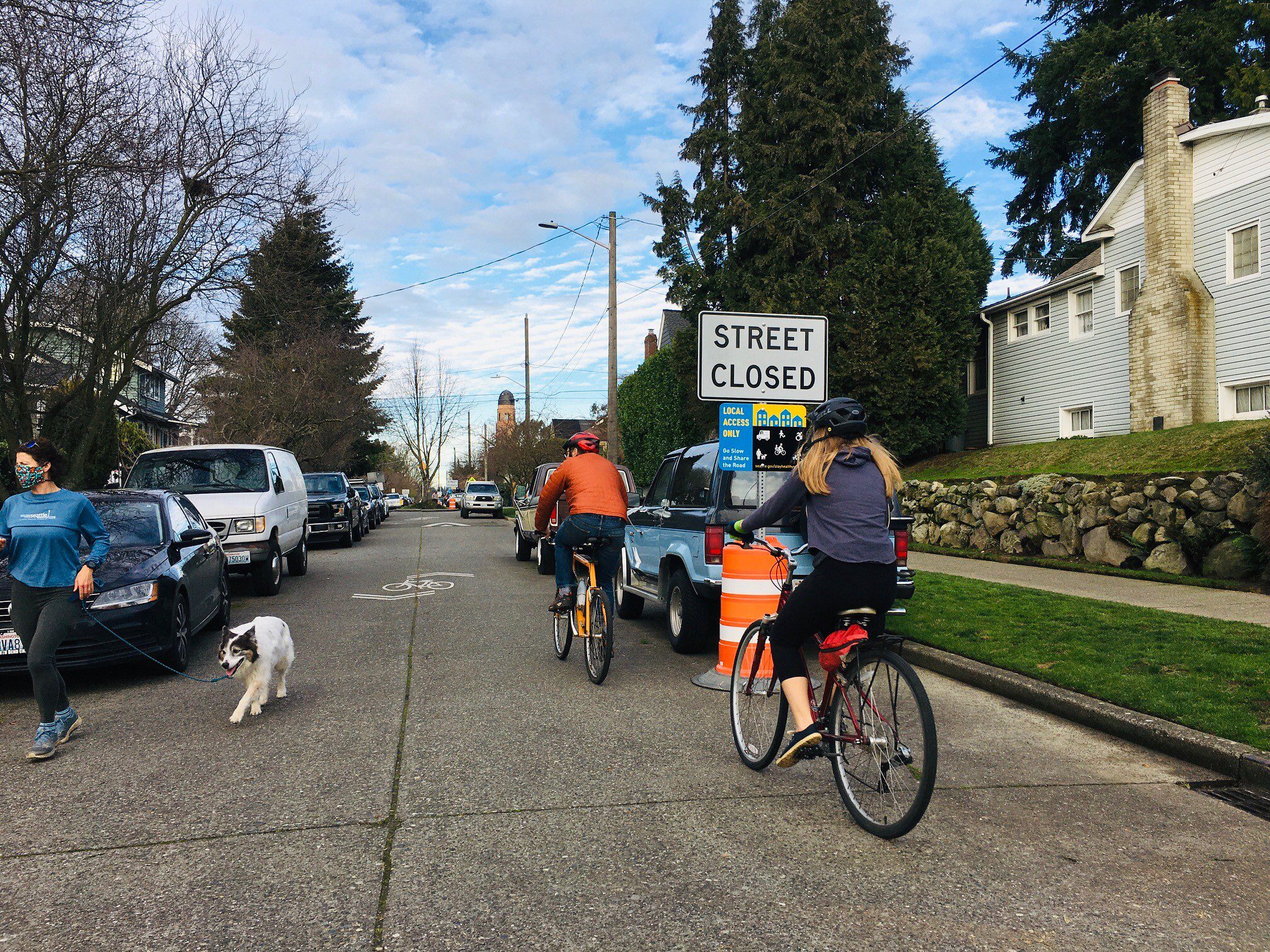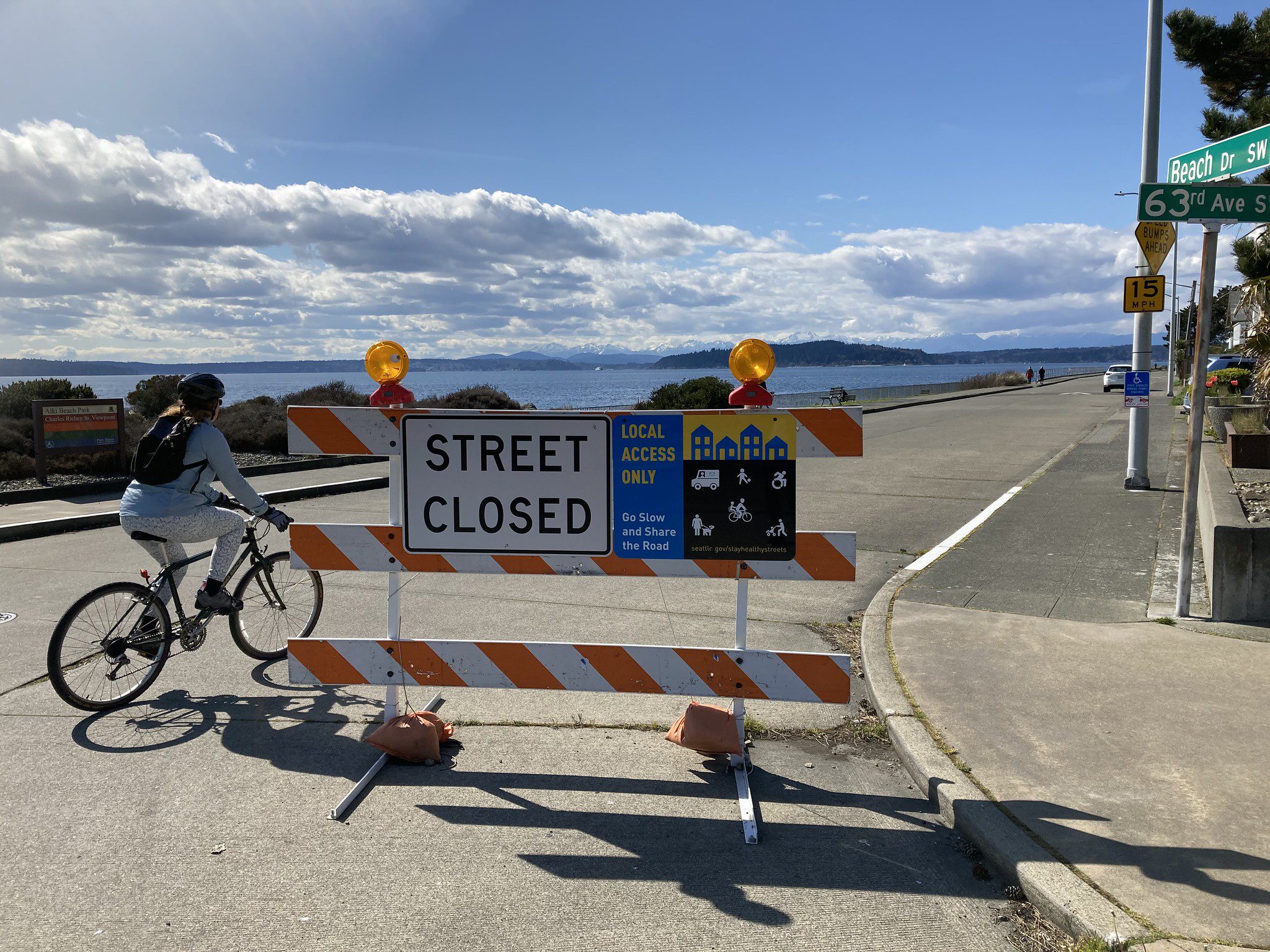 People enjoy riding bikes and jogging with their dog on a Healthy Street in 2021. Photo: SDOT.
People enjoy riding bikes and jogging with their dog on a Healthy Street in 2021. Photo: SDOT. Editor’s note (August 22, 2023): We originally published this blog post on October 12, 2022, and have updated it since then with the latest information.
Please note: you can click on the links below to jump down to any section:
- See what’s becoming permanent
- Learn about adopting a Healthy Streets Planter
- Play on your Healthy Street
- Program overview
- How public engagement informed the process
- How to stay informed
We are making 6 new Healthy Streets locations permanent!
Over the last year, we’ve been evaluating existing Healthy Streets and using community feedback to determine whether they should be made permanent or reverted to Neighborhood Greenways, as they were before the pandemic.
Based on our learnings, the following locations are becoming permanent Healthy Streets:
- Aurora-Licton Springs
- Lake City- Cedar Park and Olympic Hills
- Wallingford
- Othello/Rainier Beach
- Georgetown
- South Park
Thank you to everyone who participated in the evaluation process to make these Healthy Streets permanent! To view our evaluation results, please visit our project webpage. We will be working to change the temporary signs at these locations and add in planters and concrete bases where needed. You can expect to see these changes as soon as 2024.
The project is funded in part by the 9-year, $930 million Levy to Move Seattle.

Updated Healthy Streets City-Wide Map

Sign up to take care of a Healthy Streets Planter!
For permanent Healthy Street locations, we can install planters instead of concrete block bases at Healthy Street intersections (see diagram below). Healthy Street planters will need to be watered and maintained by neighbors.
If you are interested in requesting and taking care of a planter at your Healthy Street please click here for more information.
Below is an image of what the two permanent Healthy Streets sign options will look like. Pictured on the left is a Healthy Streets sign with a planter option, and on the right a sign with the concreate base.

Play on your Healthy Street
Many neighbors have taken advantage of the No Permit Required status of Healthy Streets to easily host their own events like community dinners, neighborhood gatherings, and Play Streets. We want to continue to celebrate and support neighbors that want to have fun on their Healthy Streets by providing FREE Healthy Street kits.
The free Play on your Healthy Street Kit includes play cones, signs, pennant flags, chalk, and more! Please click here for more information and to sign up to get your free Play on your Healthy Street Kit.
Help us spread the word about this great, community-centered program. Share your pictures on Twitter or Instagram using #PlayOnYourHealthyStreet.
Original Post (October 12, 2022)
We introduced Healthy Streets during the pandemic in 2020 as a way for Seattleites to get outside safely and stay active in local neighborhoods throughout the city. Healthy Streets are open for people walking, rolling, biking, and playing, and closed to pass-through traffic.
We’re updating our Healthy Streets across Seattle based on the trends we’ve seen in terms of community use and public feedback. Next, we will:
- Make some locations permanent Healthy Streets
- Return some locations to neighborhood greenways, which they were prior to the pandemic
- Further review some Healthy Streets and conduct more outreach to determine next steps. These locations will remain Healthy Streets until further notice.
At each location, there may be a combination of permanent Healthy Streets, neighborhood greenways, and/or areas for further review and outreach.
Here are the locations of current Healthy Streets. The plan for each can be found on the web pages below:
- Alki Point
- Aurora-Licton Springs
- Ballard
- Beacon Hill
- Bell Street Park
- Central Area
- Delridge/Highland Park
- Greenwood
- Lake City
- Little Brook
- Rainier Valley (Mt Baker/Columbia City/Hillman City)
- Othello/Rainier Beach
- South Park and Georgetown
- Wallingford
- West Seattle/High Point
Below is a map that shows the plan for Healthy Streets locations throughout the city moving forward. You can also visit our website for the latest information.

Over the next few weeks, we plan to visit all existing Healthy Street locations to check on the condition of signs and repair or replace them as needed. We’ll also remove signs on Healthy Streets that will become neighborhood greenways like they were before the pandemic. Over time, we’ll begin installing the updated signs for permanent Healthy Streets locations.

You helped us learn what works, and what doesn’t. Thank you!
We talked to people and distributed surveys to understand how Healthy Streets are working today, and what people would prefer for Healthy Streets in their neighborhood moving forward.
We observed and reviewed each Healthy Street with this input top of mind to help inform our decision-making.
People liked Healthy Streets for reasons including:
- Improved safety
- A more enjoyable neighborhood
- More open space
- Encouraging sustainable transportation
- Promoting healthy habits
But some people shared concerns and challenges, including:
- Difficulty getting around
- Ineffective signs
- Safety-related issues
- Feeling excluded
How to stay informed:
- Visit us on the web
- Sign up for email updates
- Email us at StayHealthyStreets@Seattle.gov
- Call us at (206) 684-7623
